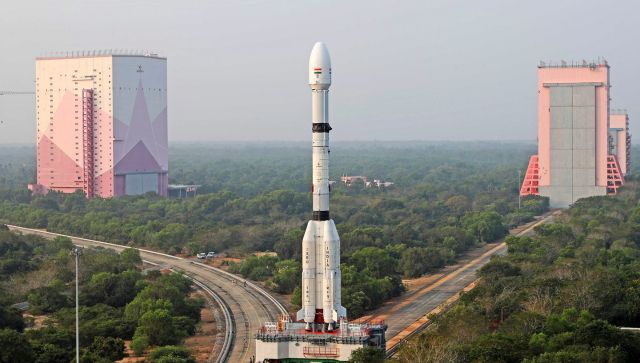What’s gslv, isro’s ‘naughty boy’ rocket that will launch the insat-3ds weather satellite today?
- Select a language for the TTS:
- UK English Female
- UK English Male
- US English Female
- US English Male
- Australian Female
- Australian Male
- Language selected: (auto detect) - EN
)
Play all audios:

THE GEOSYNCHRONOUS SATELLITE LAUNCH VEHICLE (GSLV) IS A 51.7-METRE-LONG ROCKET DUBBED ‘NAUGHTY BOY’ FOR ITS SPOTTY TRACK RECORD. IT IS BEING USED BY ISRO TO LAUNCH THE INSAT-3DS
METEOROLOGICAL SATELLITE INTO SPACE ON SATURDAY read more The Indian Space Research Organisation (ISRO) is geared up to launch its INSAT-3DS meteorological satellite at 5.35 pm on Saturday
(17 February) from the Satish Dhawan Space Centre in Sriharikota, Andhra Pradesh. The weather satellite will be aboard a Geosynchronous Satellite Launch Vehicle (GSLV), the rocket dubbed
“naughty boy” by the space agency. The GSLV-F14 intends to place the INSAT-3DS meteorological satellite into the Geosynchronous Transfer Orbit (GTO). This is the rocket’s 16th mission and
its 10th flight using the indigenously produced cryogenic engine, as per _Indian Express._ What is GSLV and why is it nicknamed ‘naughty boy’? Why is the GSLV-F14/INSAT-3DS mission
significant? Let’s take a closer look. ISRO’S ‘NAUGHTY BOY’ ROCKET The Geosynchronous Satellite Launch Vehicle is a three-stage rocket developed by ISRO to launch different spacecraft. The
first stage consists of a solid propellant (S139) motor with 139-tonne propellant and four liquid strapons each carrying 40 tonnes of propellant, as per the Indian space agency. The second
stage consists of 40 tonnes of liquid propellant. The third stage is a “cryogenic stage with a 15-tonne propellant loading of liquid oxygen (LOX) and liquid hydrogen (LH2)”, says the ISRO.
The 51.7-metre-long launch vehicle has a liftoff mass of 420 tonnes. First launched in 2001, the GSLV has had a spotty record. Out of the 15 launches using the GSLV so far, at least four
failed. To compare, only three of the 60 missions by ISRO’s Polar Satellite Launch Vehicle (PSLV) have been unsuccessful, while all seven by LVM-3 have gained success, noted _Indian
Express._ It is because of its unreliable nature that the GSLV was nicknamed the “naughty boy”. After the rocket successfully put GSAT-14 into orbit in 2014 following two failures, K Sivan,
the rocket’s project director had reportedly said at the time, “We used to call GSLV the naughty boy of ISRO. The naughty boy has become obedient and, today has meticulously done its job”.
WHY INSAT-3DS MISSION IS SIGNIFICANT INSAT-3DS, a 2,274 kg satellite, will carry forward the functions of INSAT-3D – launched in 2013 – and INSAT-3DR (September 2016), which have completed
their mission life. Funded by the Ministry of Earth Sciences, INSAT-3DS will help with more accurate forecasts and natural disaster warnings by conducting meteorological observations and
monitoring land and ocean surfaces. Once operational, the satellite will be used for short-range predictions of extreme weather events such as thunderstorms. It can also furnish visibility
estimation for aviation, and facilitate the examination of forest fire, snow cover, smoke, and climate studies, reported _Indian Express._ The satellite will provide Satellite Aided Search
and Rescue services, along with data gathering and data dissemination capabilities from the Data Collection Platforms (DCPs). > GSLV-F14/INSAT-3DS Mission: > > 27.5 hours countdown
leading to the launch on February 17, 2024, at > 17:35 Hrs. IST has commenced. pic.twitter.com/TsZ1oxrUGq > — ISRO (@isro) February 16, 2024 After about 18 minutes of launch, the
INSAT-3DS satellite will enter into a 36,647 km x 170 km elliptical orbit. Later, orbit-raising manoeuvres will be carried out to install the satellite into a Geo-stationary Orbit. This can
be done in a couple of days, as per _NDTV._ The mission is also significant for GSLV. The rocket will be deployed later this year to launch the Earth observation satellite, NISAR. NISAR,
which is being jointly developed by NASA and ISRO, will map the globe in 12 days and provide “spatially and temporally consistent” data for analysing Earth’s ecosystems, ice mass, sea level
rise and natural hazards like earthquakes and tsunamis, as per India’s space agency. _With inputs from agencies_ End of Article